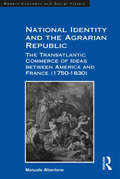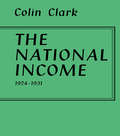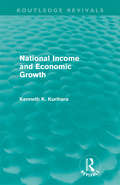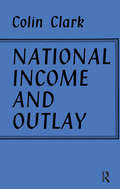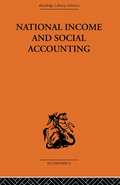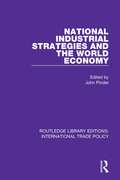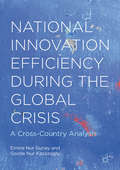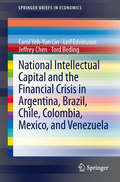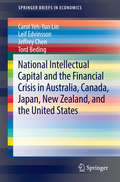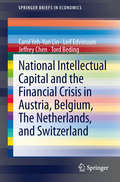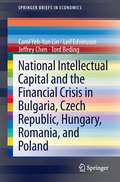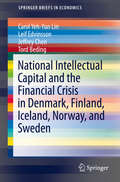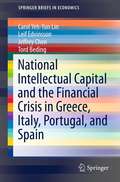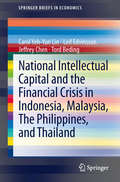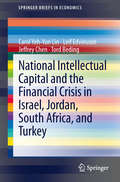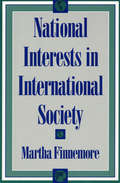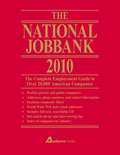- Table View
- List View
National Identity and the Agrarian Republic: The Transatlantic Commerce of Ideas between America and France (1750–1830) (Modern Economic And Social History Ser.)
by Manuela AlbertoneWith a few exceptions, historiography has paid little attention to the impact of French economic thought during the American Revolution, focusing instead on the Revolution’s links with Britain. This book outlines how, from the mid-eighteenth to the early-nineteenth century, the political and social dimension of French economic thought, and particularly of Physiocracy, spurred American Republicans to a radical shaping of American agrarian ideology. Such a perspective allows for a reconsideration of several questions that lie at the heart of contemporary historiographic debate: the connection between politics and economics; the meaning of republicanism; the foundations of representation; the role of Europe in the Atlantic world; and the interaction between national histories and global context. In particular, the research methodology adopted here makes it possible to reconstruct how American national identity, conceived as an expression of society in economic terms, emerged through a cosmopolitan way of thinking focused on the uniqueness of the new state.
National Income 1924-1931 (Reprints Of Economic Classics Ser.)
by Colin ClarkFirst Published in 1965. Routledge is an imprint of Taylor & Francis, an informa company.
National Income Accounting
by Robert E. KennedyIntroduces the concept of national income accounting. This note: 1) defines GDP and provides examples; 2) discusses the differences between GDP and GNP; 3) presents both the expenditure and income decompositions of GDP; and 4) defines the relationships among net savings, net exports, and the fiscal debate.
National Income and Economic Growth (Routledge Revivals)
by Kenneth Kenkichi KuriharaFirst published in 1961, Kenneth K. Kurihara’s National Income and Economic Growth makes a pioneering effort to integrate national income accounting, income-employment theory and growth analysis as a unified whole. In his belief that growth economics is taught most effectively as a dynamic implication of basic national income theory, Professor Kurihara offers a much fuller treatment of economic growth than most other texts of this genre. The author addresses the complex and pivotal problem of achieving the highest possible rate of growth of real national income while maintaining full employment without inflation, yet the book is confined to the clarification of the technical aspects of the problem. Professor Kurihara endeavours to make allusion to practical application and broad ‘determinants of determinants’ throughout in the varying context of a modern mixed open economy with its dynamic interaction of the private, the public and the foreign trade sectors. The book is intended for intermediate students of macro-economic theory.
National Income and Outlay
by Colin ClarkFirst published in 1937. An update of ‘The National Income’ 1924-1931. This volume collates four years of continuous work on the question of amount of expenditure on certain commodities, including new data on income from since 1932, including the Occupation and Industry volumes of the 1931 Census.
National Income and Social Accounting (Routledge Library Editions)
by Harold C. Edey Ronald Cooper Profesor Harold Edey Professor Sir Peacock Alan T. Peacock'A very useful introduction to the techniques of social accounting' Bankers' Magazine.'Remarkable feat of compression and expositionit will surely remain for a long time the best summary of macro-accounting techniques' Accounting Research. This volume covers developments both in the scope and content of official economic statistics of national income and expenditure and in their use for short-term and long-term economic planning.
National Industrial Strategies and the World Economy (Routledge Library Editions: International Trade Policy #16)
by John PinderWith the economic crisis continuing into the 1980s, the necessity to adapt industrial structures to contemporary requirements became clear. This book, first published in 1982, is a volume unique in its coverage of the major countries, industries, and international relationships that together generate the dynamic of structural change. Case studies by industrial sector and country are provided, as well as thoughtful analysis of a broad range of issues, including protectionism, foreign investment, primary production vs processing and manufacture, energy requirements, market imperfections, employment, and the growth of interdependence.
National Innovation Efficiency During the Global Crisis
by Emine Nur Gunay Gozde Nur KazazogluWhat effect did the Great Recession have on innovation efficiency and the effectiveness of scarce resource management? Did countries with high GDPs and GDPs per capita sustain efficient innovation? How did the recession affect the time lag between innovation development and implementation? This book presents the most comprehensive data set in current economic literature to measure and compare the effect of GDP and GDP per capita on the efficiency of fifty-eight countries' national innovation systems during the Great Recession. A total of eighteen different models are applied to different groupings of the data, including data envelopment analyses and time lag effects. The result is a rich comparative resource for policy makers and economists alike.
National Innovation Systems and Comparative Industry Evolution
by Henry W. Chesbrough Gillian MorrisDiscusses U.S. and Japanese innovation systems. Illustrates these with comparative studies of computer and pharmaceutical industries. Probes effects of labor, capital, and customer market institutions on these sectors in the United States and Japan.
National Instruments
by Natalie Kindred Lynda M. Applegate Keri PearlsonThis case explores the use of social media to support product design, customer support, marketing and HR activities at National Instruments (NI). Based in Austin, Texas, with over $1 billion in 2011 sales, NI designs, produces, and sells software and hardware platforms that simplify development of its customers measurement and control systems. Its customers, ranging from individuals (professors and their students) to large corporations, consist primarily of scientists and engineers-a pedigree shared by most NI employees. Since dedicating a full-time position to formalizing the use of social media tools in 2006, NI has infused social capabilities into its internal and customer-facing business processes, strengthening relationships and value delivered. NI's story deepens our understanding of how to build a social business strategy, create game changing innovation processes, and measure the value of its social technology investments-a key challenge facing the company. By touching on NI's history and culture, the case also allows students to consider what elements of this company's organization and culture have allowed it to build a robust social business model.
National Intellectual Capital
by Leif Edvinsson Carol Yeh-Yun LinOver the past decade, knowledge assets and intellectual capital have been attracting an increasing amount of attention, not only from academics and CEOs, but also from national policy makers. To date, most studies of intellectual capital have focused at the organizational level, with an emphasis on explaining the role of "intangible assets" as a differentiator between accounting value and market value as a possible source of corporate competitive advantage. More recently, pioneers in the field, including the authors of this book, have begun to apply these methodologies to a broader scope, with the objective of comparing the intellectual capital indices at the national or regional level. As a result, an increasing number of world organizations and researchers are commissioned to investigate this future-oriented crucial national issue. Yet, the linkage between the value of intangible assets and how to quantify or benchmark it is still tenuous, not to mention easily misunderstood by a layman for guiding better decision making. With the belief that numbers talk and statistics hide valuable information, this book serves to present the authors' research findings, covering 14 years (1995-2008) of intellectual capital information, comprised of human capital, market capital, process capital, renewal capital, and financial capital for 40 countries. The last three chapters go beyond analysis of current intellectual capital factors, and present practical tools for launching initiatives at the national level. The book will serve as an essential resource for researchers, policy makers, and business leaders concerned with issues of economic growth and competitiveness, innovation, and business creation.
National Intellectual Capital and the Financial Crisis in Argentina, Brazil, Chile, Colombia, Mexico, and Venezuela
by Leif Edvinsson Carol Yeh-Yun Lin Tord Beding Jeffrey ChenIn the first decade of the twenty-first century, the biggest event of worldwide proportion was the 2008 global financial crisis, which was caused primarily by ineffective governance, failed surveillance systems, and implementation flaws. While fiscal and monetary policies succeeded in pulling many countries out of a financial freefall, most economies have performed beneath pre-recession levels as governments continued to struggle with their finances. Examining the financial crisis from the viewpoint of intangible assets provides a different perspective from traditional economic approaches. National Intellectual Capital (NIC), comprised mainly of human capital, market capital, process capital, renewal capital, and financial capital, is a valuable intangible asset and a key source of national competitive advantage in today's knowledge economy. The authors--pioneers in the field--present extensive data and a rigorous conceptual framework to analyze the connections between the global financial crisis and NIC development. Covering the period from 2005 to 2010 across 48 countries, the authors establish a positive correlation between NIC and GDP per capita and consider the impact of NIC investment for short-term recovery and long-term risk control and strategy formulation. Each volume in a series of SpringerBriefs on NIC and the financial crisis provides in-depth coverage of the impact of the crisis, the aftermath, future prospects, and policy implications for a regional cluster. This volume focuses on Argentina, Brazil, Chile, Columbia, Mexico, and Venezuela.
National Intellectual Capital and the Financial Crisis in Australia, Canada, Japan, New Zealand, and the United States
by Leif Edvinsson Carol Yeh-Yun Lin Tord Beding Jeffrey ChenIn the first decade of the twenty-first century, the biggest event of worldwide proportion was the 2008 global financial crisis, which was caused primarily by ineffective governance, failed surveillance systems, and implementation flaws. While fiscal and monetary policies succeeded in pulling many countries out of a financial freefall, most economies have performed beneath pre-recession levels as governments continued to struggle with their finances. Examining the financial crisis from the viewpoint of intangible assets provides a different perspective from traditional economic approaches. National Intellectual Capital (NIC), comprised mainly of human capital, market capital, process capital, renewal capital, and financial capital, is a valuable intangible asset and a key source of national competitive advantage in today's knowledge economy. The authors--pioneers in the field--present extensive data and a rigorous conceptual framework to analyze the connections between the global financial crisis and NIC development. Covering the period from 2005 to 2010 across 48 countries, the authors establish a positive correlation between NIC and GDP per capita and consider the impact of NIC investment for short-term recovery and long-term risk control and strategy formulation. Each volume in a series of Springer Briefs on NIC and the financial crisis provides in-depth coverage of the impact of the crisis, the aftermath, future prospects, and policy implications for a regional cluster. This volume focuses on Australia, Canada, Japan, New Zealand, and the United States of America.
National Intellectual Capital and the Financial Crisis in Austria, Belgium, the Netherlands, and Switzerland
by Leif Edvinsson Carol Yeh-Yun Lin Tord Beding Jeffrey ChenIn the first decade of the twenty-first century, the biggest event of worldwide proportion was the 2008 global financial crisis, which was caused primarily by ineffective governance, failed surveillance systems, and implementation flaws. While fiscal and monetary policies succeeded in pulling many countries out of a financial freefall, most economies have performed beneath pre-recession levels as governments continued to struggle with their finances. Examining the financial crisis from the viewpoint of intangible assets provides a different perspective from traditional economic approaches. National Intellectual Capital (NIC), comprised mainly of human capital, market capital, process capital, renewal capital, and financial capital, is a valuable intangible asset and a key source of national competitive advantage in today's knowledge economy. The authors--pioneers in the field--present extensive data and a rigorous conceptual framework to analyze the connections between the global financial crisis and NIC development. Covering the period from 2005 to 2010 across 48 countries, the authors establish a positive correlation between NIC and GDP per capita and consider the impact of NIC investment for short-term recovery and long-term risk control and strategy formulation. Each volume in a series of SpringerBriefs on NIC and the financial crisis provides in-depth coverage of the impact of the crisis, the aftermath, future prospects, and policy implications for a regional cluster. This volume focuses on Austria, Belgium, the Netherlands, and Switzerland.
National Intellectual Capital and the Financial Crisis in Brazil, Russia, India, China, Korea, and South Africa
by Leif Edvinsson Carol Yeh-Yun Lin Tord Beding Jeffrey ChenIn the first decade of the twenty-first century, the biggest event of worldwide proportion was the 2008 global financial crisis, which was caused primarily by ineffective governance, failed surveillance systems, and implementation flaws. While fiscal and monetary policies succeeded in pulling many countries out of a financial freefall, most economies have performed beneath pre-recession levels as governments continued to struggle with their finances. Examining the financial crisis from the viewpoint of intangible assets provides a different perspective from traditional economic approaches. National Intellectual Capital (NIC), comprised mainly of human capital, market capital, process capital, renewal capital, and financial capital, is a valuable intangible asset and a key source of national competitive advantage in today's knowledge economy. The authors--pioneers in the field--present extensive data and a rigorous conceptual framework to analyze the connections between the global financial crisis and NIC development. Covering the period from 2005 to 2010 across 48 countries, the authors establish a positive correlation between NIC and GDP per capita and consider the impact of NIC investment for short-term recovery and long-term risk control and strategy formulation. Each volume in a series of SpringerBriefs on NIC and the financial crisis provides in-depth coverage of the impact of the crisis, the aftermath, future prospects, and policy implications for a regional cluster. This volume focuses on the BRICKS--Brazil, Russia, India, China, Korea, and South Africa.
National Intellectual Capital and the Financial Crisis in Bulgaria, Czech Republic, Hungary, Romania, and Poland
by Leif Edvinsson Carol Yeh-Yun Lin Tord Beding Jeffrey ChenIn the first decade of the twenty-first century, the biggest event of worldwide proportion was the 2008 global financial crisis, which was caused primarily by ineffective governance, failed surveillance systems, and implementation flaws. While fiscal and monetary policies succeeded in pulling many countries out of a financial freefall, most economies have performed beneath pre-recession levels as governments continued to struggle with their finances. Examining the financial crisis from the viewpoint of intangible assets provides a different perspective from traditional economic approaches. National Intellectual Capital (NIC), comprised mainly of human capital, market capital, process capital, renewal capital, and financial capital, is a valuable intangible asset and a key source of national competitive advantage in today's knowledge economy. The authors--pioneers in the field--present extensive data and a rigorous conceptual framework to analyze the connections between the global financial crisis and NIC development. Covering the period from 2005 to 2010 across 48 countries, the authors establish a positive correlation between NIC and GDP per capita and consider the impact of NIC investment for short-term recovery and long-term risk control and strategy formulation. Each volume in a series of SpringerBriefs on NIC and the financial crisis provides in-depth coverage of the impact of the crisis, the aftermath, future prospects, and policy implications for a regional cluster. This volume focuses on Bulgaria, Czech Republic, Hungary, Romania, and Poland.
National Intellectual Capital and the Financial Crisis in China, Hong Kong, Singapore, and Taiwan
by Leif Edvinsson Carol Yeh-Yun Lin Tord Beding Jeffrey ChenIn the first decade of the twenty-first century, the biggest event of worldwide proportion was the 2008 global financial crisis, which was caused primarily by ineffective governance, failed surveillance systems, and implementation flaws. While fiscal and monetary policies succeeded in pulling many countries out of a financial freefall, most economies have performed beneath pre-recession levels as governments continued to struggle with their finances. Examining the financial crisis from the viewpoint of intangible assets provides a different perspective from traditional economic approaches. National Intellectual Capital (NIC), comprised mainly of human capital, market capital, process capital, renewal capital, and financial capital, is a valuable intangible asset and a key source of national competitive advantage in today's knowledge economy. The authors--pioneers in the field--present extensive data and a rigorous conceptual framework to analyze the connections between the global financial crisis and NIC development. Covering the period from 2005 to 2010 across 48 countries, the authors establish a positive correlation between NIC and GDP per capita and consider the impact of NIC investment for short-term recovery and long-term risk control and strategy formulation. Each volume in a series of SpringerBriefs on NIC and the financial crisis provides in-depth coverage of the impact of the crisis, the aftermath, future prospects, and policy implications for a regional cluster. This volume focuses on China, Hong Kong, Singapore, and Taiwan.
National Intellectual Capital and the Financial Crisis in Denmark, Finland, Iceland, Norway, and Sweden
by Leif Edvinsson Carol Yeh-Yun Lin Tord Beding Jeffrey ChenIn the first decade of the twenty-first century, the biggest event of worldwide proportion was the 2008 global financial crisis, which was caused primarily by ineffective governance, failed surveillance systems, and implementation flaws. While fiscal and monetary policies succeeded in pulling many countries out of a financial freefall, most economies have performed beneath pre-recession levels as governments continued to struggle with their finances. Examining the financial crisis from the viewpoint of intangible assets provides a different perspective from traditional economic approaches. National Intellectual Capital (NIC), comprised mainly of human capital, market capital, process capital, renewal capital, and financial capital, is a valuable intangible asset and a key source of national competitive advantage in today's knowledge economy. The authors--pioneers in the field--present extensive data and a rigorous conceptual framework to analyze the connections between the global financial crisis and NIC development. Covering the period from 2005 to 2010 across 48 countries, the authors establish a positive correlation between NIC and GDP per capita and consider the impact of NIC investment for short-term recovery and long-term risk control and strategy formulation. Each volume in a series of SpringerBriefs on NIC and the financial crisis provides in-depth coverage of the impact of the crisis, the aftermath, future prospects, and policy implications for a regional cluster. This volume focuses on Denmark, Finland, Iceland, Norway, and Sweden.
National Intellectual Capital and the Financial Crisis in France, Germany, Ireland, and the United Kingdom
by Leif Edvinsson Carol Yeh-Yun Lin Tord Beding Jeffrey ChenIn the first decade of the twenty-first century, the biggest event of worldwide proportion was the 2008 global financial crisis, which was caused primarily by ineffective governance, failed surveillance systems, and implementation flaws. While fiscal and monetary policies succeeded in pulling many countries out of a financial freefall, most economies have performed beneath pre-recession levels as governments continued to struggle with their finances. Examining the financial crisis from the viewpoint of intangible assets provides a different perspective from traditional economic approaches. National Intellectual Capital (NIC), comprised mainly of human capital, market capital, process capital, renewal capital, and financial capital, is a valuable intangible asset and a key source of national competitive advantage in today's knowledge economy. The authors--pioneers in the field--present extensive data and a rigorous conceptual framework to analyze the connections between the global financial crisis and NIC development. Covering the period from 2005 to 2010 across 48 countries, the authors establish a positive correlation between NIC and GDP per capita and consider the impact of NIC investment for short-term recovery and long-term risk control and strategy formulation. Each volume in a series of SpringerBriefs on NIC and the financial crisis provides in-depth coverage of the impact of the crisis, the aftermath, future prospects, and policy implications for a regional cluster. This volume focuses on France, Germany, Ireland, and the United Kingdom.
National Intellectual Capital and the Financial Crisis in Greece, Italy, Portugal, and Spain
by Leif Edvinsson Carol Yeh-Yun Lin Tord Beding Jeffrey ChenIn the first decade of the twenty-first century, the biggest event of worldwide proportion was the 2008 global financial crisis, which was caused primarily by ineffective governance, failed surveillance systems, and implementation flaws. While fiscal and monetary policies succeeded in pulling many countries out of a financial freefall, most economies have performed beneath pre-recession levels as governments continued to struggle with their finances. Examining the financial crisis from the viewpoint of intangible assets provides a different perspective from traditional economic approaches. National Intellectual Capital (NIC), comprised mainly of human capital, market capital, process capital, renewal capital, and financial capital, is a valuable intangible asset and a key source of national competitive advantage in today's knowledge economy. The authors--pioneers in the field--present extensive data and a rigorous conceptual framework to analyze the connections between the global financial crisis and NIC development. Covering the period from 2005 to 2010 across 48 countries, the authors establish a positive correlation between NIC and GDP per capita and consider the impact of NIC investment for short-term recovery and long-term risk control and strategy formulation. Each volume in a series of SpringerBriefs on NIC and the financial crisis provides in-depth coverage of the impact of the crisis, the aftermath, future prospects, and policy implications for a regional cluster. This volume focuses on Greece, Italy, Portugal, and Spain.
National Intellectual Capital and the Financial Crisis in Indonesia, Malaysia, The Philippines, and Thailand
by Leif Edvinsson Carol Yeh-Yun Lin Tord Beding Jeffrey ChenIn the first decade of the twenty-first century, the biggest event of worldwide proportion was the 2008 global financial crisis, which was caused primarily by ineffective governance, failed surveillance systems, and implementation flaws. While fiscal and monetary policies succeeded in pulling many countries out of a financial freefall, most economies have performed beneath pre-recession levels as governments continued to struggle with their finances. Examining the financial crisis from the viewpoint of intangible assets provides a different perspective from traditional economic approaches. National Intellectual Capital (NIC), comprised mainly of human capital, market capital, process capital, renewal capital, and financial capital, is a valuable intangible asset and a key source of national competitive advantage in today's knowledge economy. The authors--pioneers in the field--present extensive data and a rigorous conceptual framework to analyze the connections between the global financial crisis and NIC development. Covering the period from 2005 to 2010 across 48 countries, the authors establish a positive correlation between NIC and GDP per capita and consider the impact of NIC investment for short-term recovery and long-term risk control and strategy formulation. Each volume in a series of SpringerBriefs on NIC and the financial crisis provides in-depth coverage of the impact of the crisis, the aftermath, future prospects, and policy implications for a regional cluster. This volume focuses on Indonesia, Malaysia, The Philippines, and Thailand.
National Intellectual Capital and the Financial Crisis in Israel, Jordan, South Africa, and Turkey
by Leif Edvinsson Carol Yeh-Yun Lin Tord Beding Jeffrey ChenIn the first decade of the twenty-first century, the biggest event of worldwide proportion was the 2008 global financial crisis, which was caused primarily by ineffective governance, failed surveillance systems, and implementation flaws. While fiscal and monetary policies succeeded in pulling many countries out of a financial freefall, most economies have performed beneath pre-recession levels as governments continued to struggle with their finances. Examining the financial crisis from the viewpoint of intangible assets provides a different perspective from traditional economic approaches. National Intellectual Capital (NIC), comprised mainly of human capital, market capital, process capital, renewal capital, and financial capital, is a valuable intangible asset and a key source of national competitive advantage in today's knowledge economy. The authors--pioneers in the field--present extensive data and a rigorous conceptual framework to analyze the connections between the global financial crisis and NIC development. Covering the period from 2005 to 2010 across 48 countries, the authors establish a positive correlation between NIC and GDP per capita and consider the impact of NIC investment for short-term recovery and long-term risk control and strategy formulation. Each volume in a series of SpringerBriefs on NIC and the financial crisis provides in-depth coverage of the impact of the crisis, the aftermath, future prospects, and policy implications for a regional cluster. This volume focuses on Israel, Jordan, South Africa, and Turkey.
National Interests and European Integration
by Katrin MilzowThis study combines an account of Blair, Chirac, Schröder and their attitudes towards European integration. It analyzes political discourses on 'national interests' and the EU, the frequently debated role of political discourse, the concept of national interest, and offers an alternative point of view on intergovernmental interaction.
National Interests in International Society
by Martha FinnemoreHow do states know what they want? Asking how interests are defined and how changes in them are accommodated, Martha Finnemore shows the fruitfulness of a constructivist approach to international politics. She draws on insights from sociological institutionalism to develop a systemic approach to state interests and state behavior by investigating an international structure not of power but of meaning and social value. An understanding of what states want, she argues, requires insight into the international social structure of which they are a part. States are embedded in dense networks of transnational and international social relations that shape their perceptions and their preferences in consistent ways. Finnemore focuses on international organizations as one important component of social structure and investigates the ways in which they redefine state preferences. She details three examples in different issue areas. In state structure, she discusses UNESCO and the changing international organization of science. In security, she analyzes the role of the Red Cross and the acceptance of the Geneva Convention rules of war. Finally, she focuses on the World Bank and explores the changing definitions of development in the Third World. Each case shows how international organizations socialize states to accept new political goals and new social values in ways that have lasting impact on the conduct of war, the workings of the international political economy, and the structure of states themselves.
National JobBank 2010
by Adams MediaAlphabetically arranged by state, this indispensable annual director to over 21,000 employers offers a variety of pertienent contact, business, and occupational data. - American Library Association, Business Reference and Services Section (BRASS) Completely updated to include the latest industries and employers, this guide includes complete profiles of more than 20,000 employers nationwide featuring:Full company name, address, phone numbers, and website/e-mail addressesContacts for professional hiringA description of the companys products or servicesProfiles may also include: Listings of professional positions advertisedOther locationsNumber of employeesInternships offered
